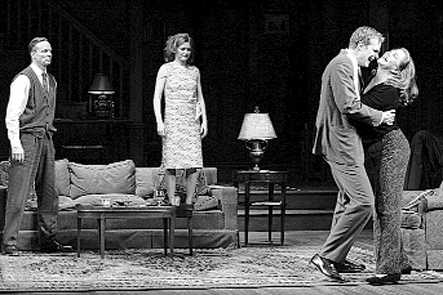Bill Irwin, Kathleen Turner brilliant in new reading of Edward Albee classic
After seeing the new production of Edward Albee’s “Who’s Afraid of Virginia Woolf?” I can add Bill Irwin’s portrayal of George in this iconic play to the pantheon of great performances.
Another actor might approach the role viewing George as a deteriorating and browbeaten alcoholic professor rallying for yet another battle with his wife, Martha. Irwin goes beyond mere vitriol and spite to exhume for the audience his love for Martha that is so profound, it renders the play both heartbreaking and, in its final moments, hopeful. This is not the popular conception of this work, and that’s all to Irwin’s credit.
There isn’t a moment in Irwin’s physically integrated, emotionally riveting performance that doesn’t feel true, whether it’s a simple gesture of the hand that denotes an habitual way of communicating, or a covert smile of recognition as the psychological games begin. The resonant feeling is that George and Martha have played out these scenes of interpersonal dysfunction, in one permutation or another, hundreds of times with a kind of tacit ease that informs the remainder of their lives. Sharp badinage is the weaponry as well as balm for their unassailable truth— the only way they know how to be with one another—and consequently their only means of contentment.
But the game has so often turned that in the round on stage it becomes obvious that a certain truth precludes an easy victory for either. The stakes have risen precipitously and the hidden tenets of their relationship are exposed and throttled, as husband and wife vie on terra incognita. That exposure is why there is a play.
The revival comes with perfect timing. For a contemporary audience, the 1960 setting foreshadows the dissolution of traditional social structures that are to come and nicely illustrates the strain of today’s pressures to return to such suffocating and prescribed roles defined ominously and pervasively as “family values.” The tyranny of convention that characterized the 1950s and the struggle of the individual in a world where family, gender or success were not malleable concepts is the trap, and George and Martha are like caged beasts.
Because they cannot attack the system, they turn on one another. Their need for the cathartic expression of rage has nowhere else to go, and they have found a kind of grim stasis in how they relate to one another. The small New England college where they are held, as much by their own devices as by external demands, is an oddly incisive metaphor for today’s conservative cultural pressures that would confine us once again. Because of this we feel the tension, the frustration and the constraint that yoke George and Martha and the irony that this life of convention and rules is something Nick, and by extension his mousy wife Honey, yearn for.
And yet, this production offers hope in a way that I’ve never seen this play convey. What this production suggests in the final and spectacularly moving final moments is that if we can somehow find the strength to strip away the lies, the deceptions, the rage and the selfishness, we might find the most unlikely thing of all—real love.
Kathleen Turner is at the top of her craft as Martha. Her fall is more precipitous and sudden than George’s, and Turner handles it with absolute precision and mastery. From the blowsy harridan of the first act, she becomes the sexual predator of the second and finally struggles toward some level of an authentic self at the end, particularly in her third-act monologue when it’s clear that she loves and needs George. Turner creates a passionate, lost Martha in a bold and fearless performance.
Also extraordinary are David Harbour as Nick and Mireille Enos as Honey. Harbour makes what might be a two-dimensional role exciting as Nick strives throughout the play to gain his footing, finding that his ego-driven plans and early success are no match for the curve balls George and Martha throw. From stoic suavity to shattered insecurity, Harbour’s Nick is an equal player, the necessary catalyst that shakes the foundations of George and Martha’s life, unable to see that he and Honey are on the way to creating their own version of George and Martha’s hell. It is unavoidable. Enos gives a deliciously subtle performance of sweetness masking passive aggression, the mouse who is running the show of her marriage with Nick.
The set by John Lee Beatty is a wonderful rendering of a campus home turned suffocating snare. There is a moment at the beginning of the third act when the front door is open, and it is the first time since Nick and Honey’s arrival that air seems to come into the dead zone. It’s a great touch.
The direction by Anthony Page is fluid and translucent, and one understands why, as Albee himself said, this is not a revival. It is truly a new way of looking at the play and a reminder that theater exists in its time.
gaycitynews.com


































